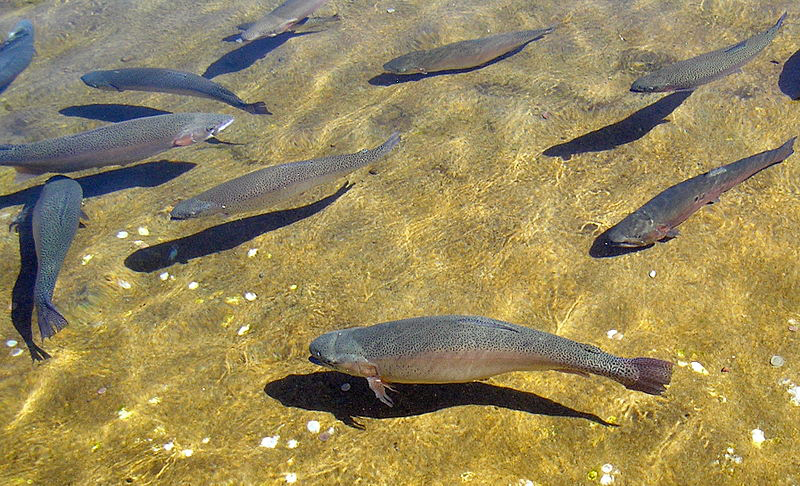Originally published in Fly Fisherman.
Fishing the Ruby River in southwestern Montana can be a joyous way to celebrate spring. But last spring was a different story.
Imagine the sickening feeling when we saw a pair of 16-inch brown trout floating belly-up in a trickle of water that was formerly the Ruby River. The dead trout were the remnants of a massive fish kill that occurred because most of the stream’s flow had been diverted for irrigation. Minimal snow pack, little spring rain, and a heavy demand for irrigation in early May reduced the flow in an l.5-mile section of the Ruby to a trickle at best. Trout became stranded in pools that eventually heated up to temperatures that for them were deadly.
Unfortunately, such stream dewatering is a recurring problem in a number of Western states, and, sadly, the additional water needed to keep the streams flowing is often of little value to other users. Indeed, as fish were dying in the Ruby, six inches of water was standing in nearby fields. It was obvious to us that the problem could have been avoided easily if only small amounts of water were transferred from irrigation to instream flows.
Seeing the fish dying in the midst of water-logged fields caused us to delve deeper into the apparent paradox. The problem goes back to the evolution of water law on the mining and farming frontier of the American West. Out of this environment developed the “prior appropriation” water doctrine, under which the first people to claim and use water obtained a priority right to it. The doctrine allowed farmers and miners to divert water from streams to where it was needed. The result often diminished the quantity–and sometimes the quality-of waler, but with many streams and few recreational demands, there was little conflict.
It is important to note that under the prior appropriation doctrine, rights can be established only by diverting water and putting it to “beneficial” use. If a rights holder leaves water in the stream, it is not considered a beneficial use, and he would lose the right since water not diverted reverts 10 the public domain and can be claimed by other diverters.
To illustrate how this “use it or lose it” principle contributes to stream dewatering, consider this example. When a Montana rancher offered an environmental group a conservation easement for Madison River water rights on the condition that the water be left in the river for trout habitat, the legal counsel for the group advised that such rights would be considered abandoned and available for diversion by others. The water is still being diverted for irrigation because of the legal impediment. Similarly, efforts by The Nature Conservancy to purchase diversion rights and leave the water flowing in Silver Creek near Sun Valley, Idaho, have been stymied by the “use it or lose it” principle.
Today, this old doctrine is generating growing conflicts between instream and off-stream users. With population and economic growth, trout fishermen frequently face the Ruby River situation. The only way for sportsmen to express their demands for water is through state agencies and the political process. As long as there is unclaimed water, state agencies throughout the West have the authority to reserve water for instream purposes. On the lower Yellowstone River, for example, the Montana Department of Natural Resources and Conservation (DNRC) has reserved 5.4 million acre feet that cannot be claimed by private users. This, however, is not the blue-ribbon stretch of the river.
The real problem exists on the upper reaches of Western rivers like the Ruby where water rights are fully claimed, and in some cases actually exceed normal flows. On these streams, sportsmen can expect tough opposition to state reservations from a coalition of agricultural, industrial, and municipal users.
With rights fully appropriated, condemnation and purchase of water rights is the only option for state agencies. The Montana Department of Fish, Wildlife, and Parks (DFWP) is empowered to purchase, condemn, or lease water rights for instream purposes, but this power has not been used widely because of the conflict it generates.
The Colorado Water Conservation Board has similar authority, but it too has to depend on reservations of unclaimed water. The board has filed applications for over 900 appropriations, but most of these are tied up in lengthy water adjudication processes. On streams where there is no unclaimed water, fishermen should be concerned that state agencies under severe fiscal constraints will not be able to continue preserving instream flows.
A recent study by the Western Governors’ Association found that “states are reluctant to try … to protect and enhance instream flows because to do so is to invite litigation.” In addition, the report says that while states have the authority to acquire instream flow rights, budgetary constraints often prevent them from doing so. We are not optimistic that trout fishermen can rely on state agencies to reserve sufficient instream flows where they are needed.
In the Ruby River case, the DNRC was able to persuade farmers to leave approximately 100 cubic-feet-per second flowing in the stream. Unfortunately, the effort was too little, too late for the dead trout. The DNHC had to depend on the good graces of the irrigators. Short of these good graces, there was little else that could be done, and any legal action by the state agency would have undoubtedly resulted in litigation.
TU Should Lease Flows
The time has come for trout fishermen to become entrepreneurs, and we think we have a plan worthy of consideration. Our proposal is for an organization such as Trout Unlimited to get in the business of “renting” or “leasing” the small amounts of water necessary to prevent the Ruby River situation.
With the low snow pack, it was easy to anticipate the dewatering problem, so it would have been easy for TU to negotiate a water contract before the problem occurred. Given that the additional value of water standing in the fields is quite low, our calculations show that the amount of water necessary to have prevented the upper Ruby River kill could have been rented for less than $4 ,000.
For trout fishermen to use private options, a major legal obstacle to ownership of instream flows must be removed. Currently, strict adherence to the prior appropriation doctrine and ‘the “use it or lose it” principle dictates that no Western states allow such ownership even on a temporary basis. Trout fishermen could have a positive impact by lobbying for removal of this legal obstacle.
With 50,000 members dedicated to bolstering trout populations, TU should be able to create a “dewatering fund.” Unfortunately, TU’s tactic for solving stream dewatering has been to rely on greater federal and state intervention. At the national level, TU’s 1987 plan of action included seeking opportunities to increase flows for salmonoid fisheries via federally reserved water rights. Local chapters have lobbied for legislation granting states greater powers in controlling instream flows. TU has been active in litigation by the Montana DFWP, claiming that prior stocking of fish constituted a beneficial use for which the DFWP is entitled to an appropriation right with higher priority than existing diversion rights. Not surprisingly, the case has created more bad will with farmers and ranchers who would lose diversion rights.
We think it would be far more effective for a committed private organization such as Trout Unlimited to put its “money where its fish are” by renting or even purchasing water from farmers. Skeptics may charge that private organizations will not be able to come up with these funds, but funding figures show that TU is very adept at raising money for projects including lobbying and litigation. For example, last year TU nationally raised several million dollars in contributions through dues, banquets, and auctions of art, fishing equipment, and guided fishing trips.
A similar organization, Ducks Unlimited, illustrates how our proposal can be used to preserve wildlife habitat. DU spends much of its resources acquiring, leasing, and managing critical habitat. DU’s track record is impressive. It has acquired more than four million acres of wetlands. To accomplish this, it has raised over $360 million since 1966 and $59 million in 1986 alone!
A recent example of DU’s protection of wetlands is the 3,246 acres of marshlands purchased jointly with The Nature Conservancy from Father Flannigan’s Boys Home of Omaha, Nebraska. The area lies between the 2,000-acre Hailstone National Wildlife Refuge and the state-owned, 6,000-acre Big Lake Wetland Complex in central Montana. The entire assemblage of federal, state, and private lands makes it one of the largest and most productive waterfowl areas in the country.
Anglers in England also rely on private initiative to protect valuable trout habitat. The Angler’s Cooperative Association (ACA), an association of anglers’ clubs, has assumed the job of monitoring the pollution of fishing streams since the l 950s-almost 20 years before the British public became concerned about pollution. Allen Edwards, director of the ACA, says: “In all, the ACA has handled over 1,500 cases of pollution and recovered hundreds of pounds in damages to enable club and riparian owners to restore their fisheries.”
Trout fishermen cannot sit back and rely on the political process to meet their demands. The money is not there in state treasuries, and well established private rights make litigation inevitable if states try to “take water” for instream purposes. The above examples show it is not only possible but also practical for private concerns to address the stream dewatering problem.
If we can succeed in lobbying to remove the “use it or loose it” legal restrictions, organizations such as Trout Unlimited can move from the political arena, where games are always zero sum, to the market arena, where “win-win” situations are possible. Following the example of Ducks Unlimited, fishermen-like duck hunters· preserving wetlands-could devote resources to improving stream flows for water while working cooperatively with other water users. By augmenting public reservations with private water leasing, your next trip to the Ruby Rivers of our country can be more pleasant outings.
[Photo credits:Montanabw]






